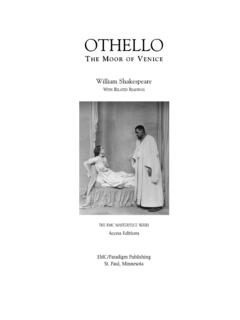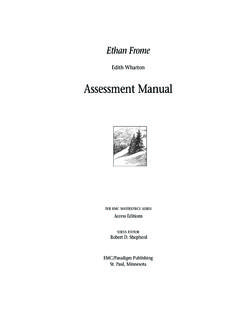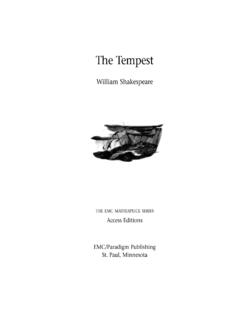Transcription of Prince of Denmark
1 William ShakespeareTHE EMC MASTERPIECE SERIESA ccess EditionsEMC/Paradigm PublishingSt. Paul, MinnesotaHAMLET,PrinceofDenmarkStaff Credits:ForEMC/Paradigm Publishing,St. Paul, MinnesotaForPenobscot School Publishing, Inc.,Danvers, MassachusettsISBN 0-8219-1633-5 Copyright 1998 by EMC CorporationAll rights reserved. No part of this publication may be adapted, reproduced,stored in a retrieval system, or transmitted in any form or by any means, elec-tronic, mechanical, photocopying, recording, or otherwise without permis-sion from the by EMC/Paradigm Publishing875 Montreal WaySt. Paul, Minnesota 55102 Printed in the United States of 9 8 7 6 5 4 3 2 xxx 06 05 04 03 02 Laurie SkibaEditorShannon O Donnell TaylorAssociate EditorEileen SlaterEditorial ConsultantJennifer J. AndersonAssistant EditorEditorialRobert D. ShepherdPresident, Executive EditorChristina E. KolbManaging EditorSara HyryEditorAllyson StanfordEditorLaurie FariaAssociate EditorSharon SalingerCopyeditorMarilyn Murphy ShepherdEditorial AdvisorDesign and ProductionCharles Q.
2 BentProduction ManagerSara DayArt DirectorDiane CastroCompositorJanet StebbingsCompositorTable of ContentsThe Life and Works of William Shakespeare .. ivTime Line of Shakespeare s Life .. viiiThe Historical Context ofHamlet, Prince of Denmark .. xEchoes .. xivIllustration .. xviDramatis Personae .. 1 ACT I.. 3 ACT II .. 53 ACT III .. 95 ACT IV .. 149 ACT V .. 187 Plot Analysis ofHamlet, Prince of Denmark .. 226 Creative Writing Activities .. 240 Critical Writing Activities .. 242 Projects .. 248 Glossary .. 250 Handbook of Literary Terms .. 257 TABLE OF CONTENTS iiiivHAMLET, Prince OF DENMARKTHE LIFE AND WORKS OFWilliam ShakespeareWilliam Shakespeare (1564 1616).William Shakespearemay well be the greatest dramatist the world has ever mother, Mary Arden Shakespeare, was from a well-to-do,well-connected family. His father, John Shakespeare, was aprosperous glove maker and local politician. William s exactbirthdate is unknown, but he was baptized in his hometownof Stratford-upon-Avon on April 26, 1564, and tradition hasassigned him a birthdate of April 23, which was also the dayof his death and the feast day of Saint George, England spatron attended the Stratford grammar school, wherehe studied Latin and perhaps some Greek.
3 At the age of eigh-teen, Shakespeare married Anne Hathaway, eight years hissenior, who was with child. Altogether, William and Anne hadthree children, a daughter Susanna and twins Hamnet andJudith. He may have worked for a while as a schoolteacher,for there are many references to teaching in his plays. By 1592,however, he was living in London and pursuing a life in thetheater. Shakespeare continued to provide for his family andto expand his holdings in Stratford while living in retired to Stratford-upon-Avon at the end of his s Professional CareerBy 1593, Shakespeare was a successful actor and history playsHenry the Sixth,Parts 1, 2, and 3, andTheTragedy of Richard the Thirdhad established him as a significantforce in London theater. In 1593, when an outbreak of theplague forced the closing of the theaters, Shakespeare turnedto narrative poetry, producingVenus and AdonisandThe Rapeof Lucrece,both dedicated to a patron, the Earl ofSouthampton.
4 When the theaters reopened, Shakespeareplunged back into his primary vocation, and wrote thirty-seven plays in less than twenty years, includingThe Taming ofthe Shrew; a midsummer night s Dream; The Merchant of Venice;Twelfth Night, or What You Will; All s Well That Ends Well; TheTragedy of King Richard the Second; The Tragedy of Romeo andJuliet; The Tragedy of Julius C sar; The Tragedy of Hamlet, PrinceWilliam ShakespeareTHE LIFE AND WORKS OF WILLIAM SHAKESPEAREvof Denmark ; The Tragedy of Othello, the Moor of Venice; TheTragedy of King Lear; The Tragedy of Macbeth; The Winter s Tale;andThe 1594, Shakespeare became a shareholder in a theatercompany known as The Lord Chamberlain s Men. The troupequickly became the most popular in London and performedregularly at the court of Queen Elizabeth I. By 1599, they werewealthy enough to build their own theater, a large open-airplayhouse they called the Globe, and in 1603 they bought theBlackfriars, a small, artificially lighted indoor theater for winterperformances.
5 After the death of Elizabeth in 1603,Shakespeare s company was renamed The King s Men, in honorof their new royal patron, King James I. Shakespeare s final non-collaborative play,The Famous History of the Life of Henry theEighth,was performed in London in 1613. Later that same year,he collaborated with John Fletcher to write a play calledTheTwo Noble that time he was probably living againin Stratford, in a large house called New Place that he hadbought in 1597. When he died in 1616, survived by his wifeand his two daughters, Shakespeare was a wealthy man. He wasburied in the Holy Trinity Church in Stratford-upon-Avon,where his bones rest to this day. The stone over his grave reads,Good frend for Jesus sake forbeare,To digg the dust encloased heare:Blest be the man that spares thes stones,And curst be he that moves my Publication of Shakespeare s PlaysShakespeare did not personally prepare his plays for publi-cation, and no official collection of them appeared until afterhis death.
6 A collection of his sonnets, considered by critics tobe among the best poetry ever written in English, appeared in1609. Many individual plays were published during his life-time in unauthorized editions known as quartos. Many ofthese quartos are quite unreliable. Some were probably basedon actors memories of the plays. Some were reprintings of so-called prompter s copies used in production of the may have been based on final manuscript versions pro-duced by the author. In 1623, seven years after Shakespeare sdeath, his friends and fellow actors John Heminge and HenryCondell published a collected edition of thirty-five ofShakespeare s plays. This collection is known to literary his-torians as the First Folio. In the centuries since 1623, andespecially during the last century and a half, editors haveworked diligently to compare the various early printedversions of Shakespeare s works to determine which versionor versions of each play best represent Shakespeare s s Finest AchievementFragments can be tantalizing.
7 They tempt people, awak-ening a desire to reconstruct the missing pieces. Since verylittle is known of Shakespeare s life beyond a few officialrecords and mentions by others in diaries or letters, manypeople have been driven to speculate about the private life ofEngland s greatest author. Such speculation is made all themore difficult by the fact that Shakespeare did not write in apersonal vein, about himself, but rather concentrated hisvision on the lives of others. Reading his plays, or seeingthem performed, we come to know many of his charactersbetter than we know most people in our lives. A character-istic of Shakespeare s greatness is that his work takes us onjourneys into parallel universes, into other minds, so that hischaracters innermost feelings, dreams, wishes, values, moti-vations, and even contradictions become accessible. This is,perhaps, Shakespeare s finest Authorship of Shakespeare s PlaysThe fact that Shakespeare was a commoner and led,according to the few facts we have, a rather ordinary life, hasled many people to speculate that his plays were written bysomeone else by the Earl of Oxford, perhaps, or by BenJonson, but there are good reasons to believe that Shakespearewas, indeed, the author of the plays attributed to him.
8 Onereason to accept the traditional attribution is that the playsshow an understanding of the lives of people in all stationsof life, from the lowliest peasants to men and women of thecourt. We know that Shakespeare came from a middle-classbackground and later moved in court circles, and this fact isconsistent with his understanding of people from all walks oflife. At the very least, a careful reader must conclude that theplays attributed to Shakespeare are the work of a singleauthor, for they have a distinct voice not to be found in thework of any other dramatist of his day a voice that hasenriched our language as none other has ever Uniqueness of Shakespeare s WorkNo brief summary can begin to catalog the many virtuesof Shakespeare s work. He was a gifted observer of people,capable of creating unforgettable characters from all stationsand walks of life. He used one of the largest vocabularies everemployed by an author, filling his plays with concrete detailsviHAMLET, Prince OF DENMARKand with speech that, while not always realistic, is alwaysengaging and believable.
9 His plays probe the range of humanexperience. They are romantic in the sense that they are fullof intensely conveyed passion. However, the plays rarelystrain credibility or sink into sensationalism or sentimental-ity. Shakespeare s language tends to be dense, metaphorical,full of puns and word play, and yet natural, so that itcomes trippingly off the tongue of an actor. A scene ofShakespeare tears across the stage, riveting and dramatic, andyet it bears close rereading, revealing in that rereading aston-ishing depth and complexity. Shakespeare wrote his dramas ina combination of prose, rhymed poetry, and blank versealways appropriate to the character or scene at hand. Hisplays have contributed many now well-known phrases to theEnglish language. They have inspired audiences to laughter,joy, pity, fear, sadness, despair, and suspense for over fourhundred years. In fact, his works have been performed moreoften and in more countries around the world than those ofany other dramatist.
10 To begin to read Shakespeare is to entera world, one might say the world, for his art is, as Hamletsays it should be, a mirror held up to nature to humannature. To read him well is to begin to understand others andourselves. As Ben Jonson wrote, Shakespeare s art is not ofan age, but for all time. THE LIFE AND WORKS OF WILLIAM SHAKESPEARE viiviiiHAMLET, Prince OF DENMARKA pril 23, 1564 April 26,15641582158315851589 15911592 15931592 1594c. 15931593 15941594 159515951595 15961596 159715961597159715981598 15991599 Time Line of Shakespeare s LifeWilliam Shakespeare is born in Stratford-upon-Avon, to parents MaryArden Shakespeare and John Shakespeare is Shakespeare marries Anne s first daughter, Susanna, is born and Hathaway Shakespeare gives birth to twins: a boy, Hamnet, and agirl, s first histories,Henry the Sixth,Parts 1 and 2, are Tragedy of Richard the Thirdis produced. Not long afterward, the plagueafflicts London and the theaters close.









